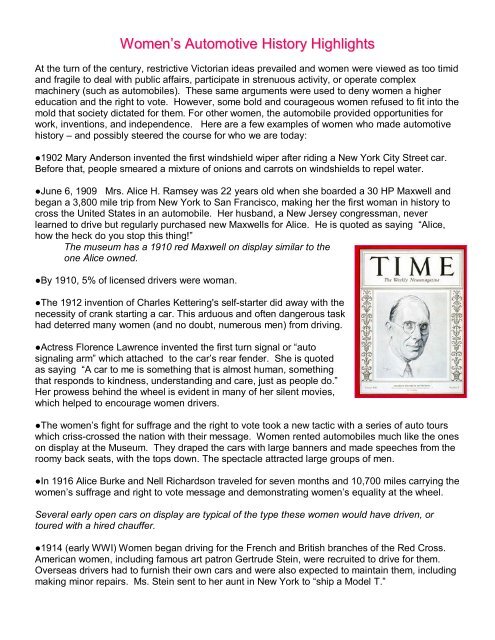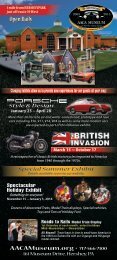Women's Automotive History Highlights - AACA
Women's Automotive History Highlights - AACA
Women's Automotive History Highlights - AACA
Create successful ePaper yourself
Turn your PDF publications into a flip-book with our unique Google optimized e-Paper software.
Women’s <strong>Automotive</strong> <strong>History</strong> <strong>Highlights</strong><br />
At the turn of the century, restrictive Victorian ideas prevailed and women were viewed as too timid<br />
and fragile to deal with public affairs, participate in strenuous activity, or operate complex<br />
machinery (such as automobiles). These same arguments were used to deny women a higher<br />
education and the right to vote. However, some bold and courageous women refused to fit into the<br />
mold that society dictated for them. For other women, the automobile provided opportunities for<br />
work, inventions, and independence. Here are a few examples of women who made automotive<br />
history – and possibly steered the course for who we are today:<br />
●1902 Mary Anderson invented the first windshield wiper after riding a New York City Street car.<br />
Before that, people smeared a mixture of onions and carrots on windshields to repel water.<br />
●June 6, 1909 Mrs. Alice H. Ramsey was 22 years old when she boarded a 30 HP Maxwell and<br />
began a 3,800 mile trip from New York to San Francisco, making her the first woman in history to<br />
cross the United States in an automobile. Her husband, a New Jersey congressman, never<br />
learned to drive but regularly purchased new Maxwells for Alice. He is quoted as saying “Alice,<br />
how the heck do you stop this thing!”<br />
The museum has a 1910 red Maxwell on display similar to the<br />
one Alice owned.<br />
●By 1910, 5% of licensed drivers were woman.<br />
●The 1912 invention of Charles Kettering's self-starter did away with the<br />
necessity of crank starting a car. This arduous and often dangerous task<br />
had deterred many women (and no doubt, numerous men) from driving.<br />
●Actress Florence Lawrence invented the first turn signal or “auto<br />
signaling arm” which attached to the car’s rear fender. She is quoted<br />
as saying “A car to me is something that is almost human, something<br />
that responds to kindness, understanding and care, just as people do.”<br />
Her prowess behind the wheel is evident in many of her silent movies,<br />
which helped to encourage women drivers.<br />
●The women’s fight for suffrage and the right to vote took a new tactic with a series of auto tours<br />
which criss-crossed the nation with their message. Women rented automobiles much like the ones<br />
on display at the Museum. They draped the cars with large banners and made speeches from the<br />
roomy back seats, with the tops down. The spectacle attracted large groups of men.<br />
●In 1916 Alice Burke and Nell Richardson traveled for seven months and 10,700 miles carrying the<br />
women’s suffrage and right to vote message and demonstrating women’s equality at the wheel.<br />
Several early open cars on display are typical of the type these women would have driven, or<br />
toured with a hired chauffer.<br />
●1914 (early WWI) Women began driving for the French and British branches of the Red Cross.<br />
American women, including famous art patron Gertrude Stein, were recruited to drive for them.<br />
Overseas drivers had to furnish their own cars and were also expected to maintain them, including<br />
making minor repairs. Ms. Stein sent to her aunt in New York to “ship a Model T.”
Many such automobiles are on display including a later 1941 Lincoln Zepher Ambulance, typical of<br />
WWII domestic Women’s Motor Corp.<br />
●In 1915 Wilma Russey became the first woman to work as a taxi driver in New York and was an<br />
expert garage mechanic.<br />
●1916 The Girl Scouts initiated a “Automobling Badge” for which girls had to demonstrate driving<br />
skill, auto mechanics, and first aid skills.<br />
●In the 1920s women educated in home economics criss-crossed the country visiting women on<br />
farms and giving home canning demonstrations. For the isolated farm women, these visits were<br />
referred to as “a little bit of heaven come down in a Tin Lizzie.” (Ford Model T).<br />
The Museum has several Model Ts on display.<br />
●In 1922 Henry Ford opened his Phoenix Factory employing women to do assembly and welding<br />
work. Workers at this plant were either single or widowed, as Mr. Ford did not approve of married<br />
women working outside the home. He said “I consider women only a temporary factor in industry.<br />
Their real job in life is to get married, have a home and raise a family. I pay our women the same<br />
as men so they can dress attractively and get married.”<br />
●Beginning in the 1920’s and 1930’s many<br />
major automobile manufacturers recognized<br />
the growing trend of women driving for fun<br />
and necessity. They began to gear their<br />
print ad campaigns to women, hire women in<br />
design and sales positions, and recognize<br />
women in many other ways.<br />
At the museum, these influences can be<br />
seen n interior and exterior examples of<br />
color options, vanity cases, plush upholstery,<br />
decorative door handles, and even interior<br />
mounted<br />
sterling silver<br />
bud vases!<br />
Interpretive<br />
visual labels<br />
also reinforce<br />
this story.
● Helene Rother (1908-1999)<br />
was a French designer of jewelry and fashion accessories who<br />
fled Nazi-occupied France with her seven-year-old daughter Ina<br />
in 1942. She was the first woman to work as an automotive<br />
designer when she joined the interior styling staff of General<br />
Motors in Detroit in 1943. Four years later she opened her own<br />
design studio in the Fisher Building, where she specialized in<br />
designs for automotive interiors, furniture and stained glass<br />
windows. She spent her later years at her horse farm near<br />
Metamora, Michigan.<br />
Car advertisements show how marketers after WWII in the late<br />
40’s and 50’s tried to make automobiles a symbol of the<br />
owner’s personality and psyche.<br />
● During World War II, American auto manufacturers<br />
stopped making cars and converted their assembly lines<br />
and factories over to war production. The supply of new<br />
automobiles dried up.<br />
After the war, reverting to peacetime production took a<br />
while: American factories produced fewer cars in 1945<br />
(dealers sold just under 70,000 cars) than they had in<br />
1909, before the advent of mass production.<br />
The prevailing motto of the day was “Do the job he left<br />
behind” as women pumped gas and did other jobs<br />
traditionally done by men.<br />
● 1956 Chicago Auto Show<br />
In this close-up view of a Custom Royal La<br />
Femme 4-door hardtop, at the Dodge exhibit<br />
space, the car is on a raised platform with a<br />
rotating floor. Two female models are next to<br />
the vehicle, while a spokesman at left points to<br />
the car. Note the open umbrella, which was part<br />
of the accessory package that came with the La<br />
Femme model--unabashedly aimed at women.



